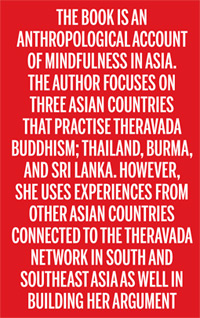
Remembering the Present: Mindfulness in Buddhist Asia by J. L. Cassaniti (2018). Cornell University Press; Illustrated edition (April 15, 2018). Paperback $31.62 : 318 pages. ISBN-10 1501709178
‘If you don’t have sati, you can’t even see a cave in the woods. If you have sati, you can see even a vapor particle of a fine mist.’
 The author Cassaniti has been meditating in the Vipassana Meditation Centre, Dharamshala, India. The place offers a silent meditation retreat, where the participants will be in complete silence for ten days. The day starts at 4.30 in the morning, followed by the main meal of the day, breakfast.
The author Cassaniti has been meditating in the Vipassana Meditation Centre, Dharamshala, India. The place offers a silent meditation retreat, where the participants will be in complete silence for ten days. The day starts at 4.30 in the morning, followed by the main meal of the day, breakfast.
Then the participants will be meditating for ten hours per day in hour-long sessions, with five-minute break after every hour. The last meal of the day will be offered at 11.30 am. Apart from being silent, the participants are not supposed to read or write in these ten days. The author articulates her mental and physical struggles for these ten days and how she experienced the outside world – wind, noise, people – after the retreat.
Mapping mindfulness
The book is an anthropological account of mindfulness in Asia. The author focuses on three Asian countries that practise Theravada Buddhism; Thailand, Burma, and Sri Lanka. However, she uses experiences from other Asian countries connected to the Theravada network in South and Southeast Asia as well in building her argument. She explores various mindfulness practices; the multiple ways of interpreting mindfulness and how modern scientific psychological treatments are presented with components of mindfulness. Most importantly, she analyses mindfulness concerning the political, social, and economic situations in the countries.
Ethnographic storytelling
The author draws exotic and complete pictures of her trails in Asia combining them with the book’s main focus, mindfulness. She gives attention to small details, the expressions in people’s faces, the vibe of the places, the feelings she had when meditating and how she felt the outside world after coming out from the meditation retreat. The book is written in a story-like style and is a fascinating read.
She rides her motorcycle to different places, participates in various meditation retreats and engages with multiple layers of people, including monks, nuns, drunkards who talk about mindfulness in a bar, people with mental health conditions and health staff of a psychiatric hospital. The author takes the readers through a journey of mindfulness in Asia. Instead of being detached from the research field and writing about it, she is much in the picture, engaging with people and incidents, connecting her experiences with respective societies.
Case of Thailand
After reading the book, Thailand becomes one’s own experience. The author takes readers to different places in Thailand, rural areas with thick forests and caves, urban areas with heavy traffic and corners of everyday Thai life. At times, one is the pillion passenger on her motorcycle, or siting in the back of a pickup truck with few people or travelling in a noisy and crowded train to different field sites in Thailand. Cassaniti draws a vivid imagery of Thailand in her story-telling.
Unlike in Sri Lanka, where monkhood is practised for a lifetime, Thailand has a system where anyone can become a monk for a short time. Thus, almost every person is aware of mindfulness. It is extensively practised in everyday life. Other than the Buddhist clergy, the advertisement industry, soap operas, meditation gurus and military leaders preach about the importance of mindfulness. In 2014, as a result of a military coup, General Prayuth Chan-ocha became the Prime Minister of Thailand. He promised mindfulness for the people. The promise was appreciated as mindfulness was already a power-wielding mechanism in Thai society. As author argues beautifully, under the cover of mindfulness, the Thai military junta undermined active dynamics of citizenship.
Case of Sri Lanka
The fourth chapter concerns mindfulness in Sri Lanka. In this chapter, the author discusses how mindfulness in Sri Lanka differs from the other two study fields she was interested in – Thailand and Burma.
She was in Kandy, interviewing students from the University of Peradeniya about mindfulness, interviewing bhikkhus at the Sri Lanka International Buddhist Academy and interviewing staff, including psychiatrists from the mental health ward at the general hospital, Kandy, all providing narratives for her master text.
She identifies Sri Lankan religiosity as more politicised than in Thailand or Burma.
According to the author, the relationship between the Buddhist clergy and laity is distant in Sri Lanka. She argues that this distance is due to the lifelong monkhood in Sri Lanka, which is dissimilar to Thailand or Burma, where people can enter into the monkhood easily and return to worldly life after.
TAPES
Cassaniti recognises five domains of mindfulness throughout Theravada Asia that, in their expression, contrast with how mindfulness is commonly understood in the United States and other “Western” countries. She calls these domains TAPES of mindfulness; Temporality, Affect, Power, Ethics and Selfhood.
The TAPES of mindfulness run across our minds as guiding principles for interacting with the world around us. At the end of many chapters, the author analyses and presents the gathered data using TAPES.
However, I found this method of presenting data is an obstruction to enjoying an otherwise beautifully written ethnography.
Anushka Kahandagamage is a Doctoral Candidate in the School of Social Sciences, University of Otago.
